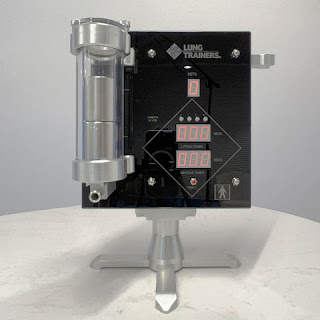Why hadn't we thought of exercising our breathing muscles before?
Since the 1970s, research has been conducted on respiratory muscle training. However, due to various training methods, such as pressure-threshold training, voluntary hyperventilation, and hypercapnic (increased CO2) hyperventilation, as well as the range of outcome measures employed, the results are contradictory. The validity of the respiratory muscle training hypothesis has been clouded by these contradictory findings. The PowerLunge, PowerBreathe, and Expand-a-Lunge are a few pieces of equipment that are now on the market that claim to speed up your marathon time or make working out more comfortable. Respiratory muscle training does improve exercise performance in healthy and clinical populations, according to the current scientific consensus and technology advancements.
This effect's mechanism appears to have two parts:
gadget for uses breathing training device seems easier due to a changed perception of effort and workload; this psychological influence should not be ignored when engaging in rigorous exercise!
Exercise at a high intensity can be maintained for a longer period thanks to a delayed metaboreflex, which prevents blood from the skeleton from being sent to the respiratory muscles unless there is a high level of exertion.
Together, these impacts have the potential to significantly improve cycling performance during a 40K time trial, increasing it by up to 4%.
Acute (within 1 training session) vibrational stimulation of skeletal muscle exercise has been shown to improve skeletal muscle activation and strength performance both after 1 session and with superimposed vibrations. Chronic exercise has been found to boost power. greater than standard strength training by 300%. Additionally, vibration has been applied to the respiratory muscles, resulting in increased respiratory nerve activity, decreased wheezing in healthy adults, and reduced wheezing during exercise in people with chronic obstructive pulmonary disease. There is less flowering now.

We designed quick airway constrictions, replicating the vibration effect on the respiratory system since vibration had not before been used in a training device for the respiratory system (you breath). According to preliminary findings, after 10 breaths while breathing through you, your breath force increases by roughly 15%, but after 10 breaths while breathing against the same amount of resistance, there is no rise. Further research is being done to look at the long-term training advantages of breathing, and these results have now been published in Respiration Physiology & Neurobiology.
Additionally, there is an ongoing partnership with clinical partners to evaluate the effectiveness of U Breathe in patients with cystic fibrosis and chronic obstructive lung disease who are complementing respiratory physiotherapy with U Breathe. We are investigating the possibility that the effect of your breathing on these individuals' respiratory function could assist in clearing mucus.
In other words, research into vibration training is still in its infancy while research into respiratory muscle training is beginning to earn real legitimacy. The mechanism of action and the proper vibrational prescription for the intended outcomes are just two of the unresolved problems. Respiratory vibration has intriguing promise for scientists, athletes, and patients alike, but its potential advantages have not yet been properly investigated.
Source URL:- https://sites.google.com/view/lungtrainers090/home

Comments
Post a Comment